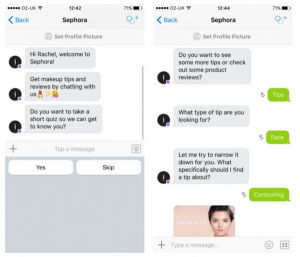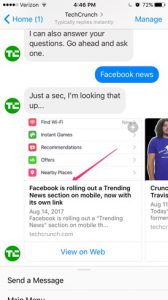Chatbots are becoming a reality … we all know it and marketers are starting to take advantage of the technology to interact with customers. Nothing is quite like them and it changes the way that our brands talk to target audiences.
They seem to be everywhere—on every platform. They create a sense of convenience and helpfulness that customers are craving!
According to Tech Crunch Facebook, chatbot has over 1.2 billion monthly users. That is crazy! Not to mention that there are plenty of other bots like Kik, Slack, WeChat, and so many more being created every day.
We agree with so many other authorities in social media that bots are the future of marketing and how brands communicate.
But, since Chatbots are a fairly new technology that a lot of us (including me) struggle with, brands are in the beginning stages of creating a conversation that flows.
Because let’s face it, no brand wants to be left in the dust by not using the newest technology— and Chatbots are the latest and greatest—even if they annoy the heck out of us most of the time.
Siri… I’m looking at you.
One of the biggest challenges with marketers creating bots is having the messaging be totally off. Creating a conversational flow and understanding that a bot doesn’t understand sarcasm, or remember past conversations can be difficult.
Marketers are focusing on the content since bot development is the easy part! Take platforms like Motion.ai andbuilding a bot that have an easy template flowchart for you to see the whole process at once—no crazy code or intense webs of conversation.
Since Chatbots provide a one-on-one conversation, unlike other social platforms, it is a chance for marketers to really have a conversation with a buyer. Creating more than a couple of witty lines of messaging is not enough.
So, here a beginner’s guide to creating a conversational flow that actually engages your customers and keeps a great customer experience.
Connect
The first step to a successful conversations bot is talking to your audience and connecting with them. Understanding your audience is key and where they spend their time on social media so you can be there when a problem arises.
For example, Facebook has a great messenger app that is the best option for people over the age of 18. Whereas people younger than 18 have gravitated to Kik.
Use a conversation tone and make the copy feel like the customer is talking with a person and is true to your brand’s personality. Try emoji’s or exclamation points, and stay away from the copy being too formal.

Sephora Chatbot
Image: HigherVisability
Take for example, the Sephora bot above. The conversation begins super casual. It focuses on getting to know the customer’s needs—almost as if they are being greeted in the store.
This attention to the customer is where Chatbots should always start. As customers return to online shopping with Chatbots they will be able to remember accurate details about what they ordered last, left reviews on, and returned. This provides a whole new space for marketers to work in.
Understand
Let’s debunk a myth right now. Chatbots are not supposed to be “chatty.” They are here for the purpose of getting to know the necessary information that they need to better help the customer.
So, think about what you want the goal to be for the customer. Start with a leading question that can help you narrow down what they are looking for specifically. Then, alter the follow up questions until you can come to the solution that they are looking for!
Think of the who, what, when, where, and why of the customer and start to answer those questions.
Deliver
The best Chatbots will deliver a soliton to a problem without forcing the customer to leave the website or download an app because, let’s face it, people simply aren’t downloading apps anymore.
Take a look at how TechCrunch’s Facebook Messenger bot delivers content via Instant Articles so that their users don’t have to load their websites.

TechCrunch Chatbot
Refine
Chatbots continues to collect data on every single instance a customer interacts with the website. That means marketers have volumes of data! So, as people start to use your Chatbot make sure that you keep pace. You’ll want to go back and narrow down a your customer’s purpose/intent faster and faster.
Understand how to talk to your customers and apply the conversational flow that happens naturally to your Chatbot.
We suggest that if you have over-the-phone or in-person conversations with your customer, take note of what they ask and what gets you to the problem quicker. Then, apply that solution to your Chatbot.
If you have any tips on how you created a conversational flow with you Chatbot please share it with us below! We love to hear the #SMSsummit community thoughts, and make sure you follow along with our weekly newsletter.









